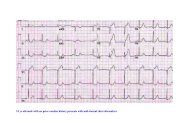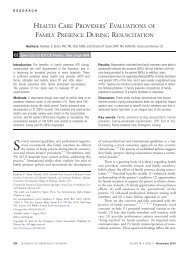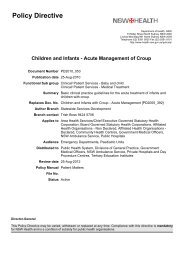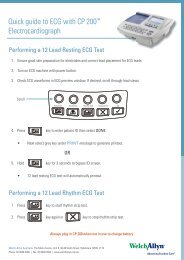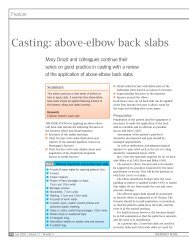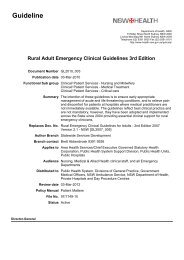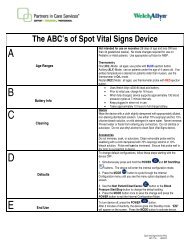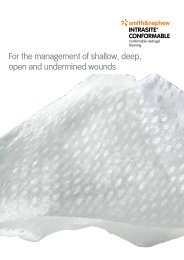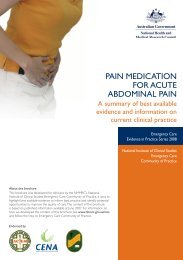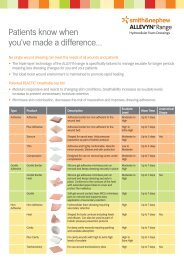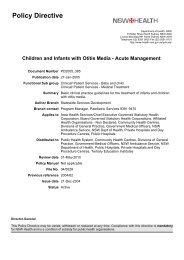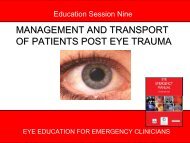Clinical Guidelines for Acute Stroke Management - Living on the EDge
Clinical Guidelines for Acute Stroke Management - Living on the EDge
Clinical Guidelines for Acute Stroke Management - Living on the EDge
You also want an ePaper? Increase the reach of your titles
YUMPU automatically turns print PDFs into web optimized ePapers that Google loves.
9.1 Organisati<strong>on</strong> of care<br />
Secti<strong>on</strong> 9 Cost and Socioec<strong>on</strong>omic Implicati<strong>on</strong>s<br />
9.1.1 <str<strong>on</strong>g>Stroke</str<strong>on</strong>g> Unit Care<br />
To date <strong>the</strong>re has been <strong>on</strong>e systematic review identified<br />
that included three studies comparing <strong>the</strong> costs and<br />
outcomes of stroke units to that of general wards. 476<br />
All three studies were based in Europe (UK, Sweden<br />
and Germany) and included costs of community and<br />
outpatient care. All three studies found modest cost<br />
savings (3-11%) using stroke unit care, however, <strong>the</strong><br />
figures failed to reach significance. The authors c<strong>on</strong>cluded<br />
that <strong>the</strong>re was “some” evidence <str<strong>on</strong>g>for</str<strong>on</strong>g> <strong>the</strong> costs to be at<br />
least equivalent to c<strong>on</strong>venti<strong>on</strong>al care.<br />
More recently, an Australian prospective cohort study<br />
comprising 468 patients from Melbourne has been<br />
published. 477 The investigators determined that care<br />
delivered in geographically localised units was costeffective<br />
compared with general medical wards or mobile<br />
stroke (inpatient) teams and that <strong>the</strong> additi<strong>on</strong>al cost in<br />
providing stroke units compared with general medical<br />
wards was found to be justified given <strong>the</strong> greater health<br />
benefits in terms of delivering best practice processes of<br />
care and avoiding severe complicati<strong>on</strong>s. When compared<br />
to general medical care costs ($12,251), costs <str<strong>on</strong>g>for</str<strong>on</strong>g> mobile<br />
teams were significantly higher ($15,903 p=0.024), but<br />
borderline <str<strong>on</strong>g>for</str<strong>on</strong>g> stroke units ($15,383 p=0.08). This was<br />
primarily explained by <strong>the</strong> greater use of specialist medical<br />
services. The incremental cost-effectiveness of stroke unit<br />
over general wards was $AUD9,867 per patient achieving<br />
thorough adherence to clinical processes and<br />
$AUD16,372 per patient with severe complicati<strong>on</strong>s<br />
avoided, based <strong>on</strong> costs to 28 weeks.<br />
These findings generally accord with internati<strong>on</strong>al studies,<br />
such as that c<strong>on</strong>ducted by Patel et al (2004). 478 This<br />
is <strong>the</strong> first Australian study to detail <strong>the</strong> costs and<br />
cost-effectiveness of different acute care models, and it<br />
provides important in<str<strong>on</strong>g>for</str<strong>on</strong>g>mati<strong>on</strong> to underpin increased<br />
investment in stroke units.<br />
Fur<strong>the</strong>r, o<strong>the</strong>r work by Moodie et al (2004) has<br />
dem<strong>on</strong>strated that when modelled over <strong>the</strong> lifetime<br />
of a cohort of first-ever stroke patients, stroke units<br />
when compared to general medical care, produced<br />
c<strong>on</strong>siderable gains in terms of health benefits with <strong>the</strong>se<br />
additi<strong>on</strong>al benefits associated with additi<strong>on</strong>al costs.<br />
There was an additi<strong>on</strong>al lifetime cost of $1,288 per<br />
DALY recovered, or alternatively $20,172 per stroke<br />
averted or $13,487 per premature death averted.<br />
It was determined that <strong>the</strong> stroke unit interventi<strong>on</strong><br />
was cost-effective given <strong>the</strong> small additi<strong>on</strong>al costs<br />
per extra unit of benefit gained. 479<br />
Currently, <strong>on</strong>ly 19% of public hospitals report providing<br />
stroke unit care 480 and <strong>the</strong>re is clustering of stroke units<br />
in large urban centres. <str<strong>on</strong>g>Stroke</str<strong>on</strong>g> units improve outcomes <str<strong>on</strong>g>for</str<strong>on</strong>g><br />
people with stroke (see secti<strong>on</strong> 1.1). Fur<strong>the</strong>r ec<strong>on</strong>omic<br />
modelling work has predicted that if access to stroke<br />
units was improved to 80% from a baseline of 25%, <strong>the</strong>n<br />
more than 8,374 DALYs could be recovered. 481 Although<br />
this literature does not specifically indicate <strong>the</strong> real costs<br />
of setting up a stroke unit, <strong>the</strong>re is evidence that health<br />
services should be organised to provide stroke unit care<br />
and that c<strong>on</strong>siderable gains in terms of health benefits<br />
could be achieved.<br />
9.1.2 Care Pathways and <str<strong>on</strong>g>Clinical</str<strong>on</strong>g> Practice<br />
<str<strong>on</strong>g>Guidelines</str<strong>on</strong>g><br />
The effectiveness of care pathways in stroke management<br />
is variable and <strong>the</strong> effects <strong>on</strong> length of stay and costs<br />
are inc<strong>on</strong>clusive. 44, 482 To date <strong>the</strong>re has not been a costeffectiveness<br />
study <str<strong>on</strong>g>for</str<strong>on</strong>g> care pathways in stroke, but <strong>the</strong>re<br />
is evidence that <strong>the</strong> setting of use may be important.<br />
The study (pre-post audit design) c<strong>on</strong>ducted by Read<br />
and Levy (2006) has shown that implementati<strong>on</strong> of<br />
pathways in regi<strong>on</strong>al Queensland can assist in improving<br />
adherence to important processes of care, such as early<br />
access to allied health, improved use of antithrombotic<br />
agents in eligible cases at discharge and estimati<strong>on</strong> of<br />
blood glucose levels. 483 Similar studies c<strong>on</strong>ducted in<br />
Victoria have also indicated improved adherence to some<br />
important processes of care with use of care pathways or<br />
clinical management plans. 20, 24, 484 More recent evidence<br />
may suggest better effectiveness in acute settings than<br />
rehabilitati<strong>on</strong> settings. 45 It also appears that factors, such<br />
as <strong>the</strong> experience of <strong>the</strong> specialist team in managing<br />
stroke, may be important, with <strong>the</strong> use of such plans<br />
more effective in settings that have newly organised<br />
stroke services.<br />
There has been <strong>on</strong>e study c<strong>on</strong>ducted in Italy that has<br />
examined whe<strong>the</strong>r adherence to clinical practice<br />
guidelines influences <strong>the</strong> cost of acute stroke care.<br />
N<strong>on</strong>-compliance with guidelines was shown to be<br />
associated with increased costs (<str<strong>on</strong>g>for</str<strong>on</strong>g> every unit of<br />
n<strong>on</strong>-compliance <strong>the</strong>re was a 1.38% increase in hospital<br />
costs). 485 Locally, evidence published from <strong>the</strong> SCOPES<br />
study indicates that greater adherence to important<br />
clinical processes of care occur more often in stroke units<br />
and <strong>the</strong>re is also a reducti<strong>on</strong> in severe complicati<strong>on</strong>s,<br />
which when <strong>the</strong>se measures are used as proxies of health<br />
outcome indicate that <strong>the</strong>se units are more cost-effective<br />
than o<strong>the</strong>r care modalities. 477 In SCOPES, hospitals with<br />
58



